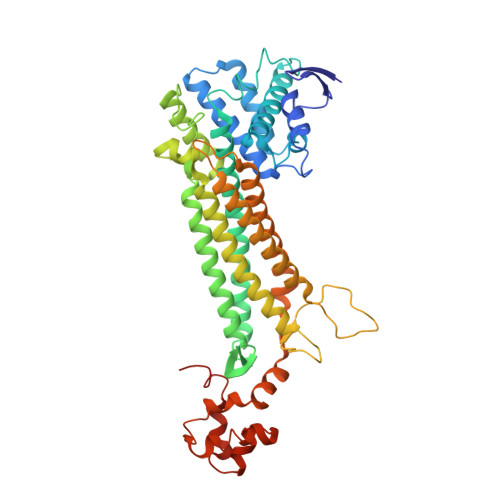Structural basis for the catalytic mechanism of aspartate ammonia lyase.
Fibriansah, G., Veetil, V.P., Poelarends, G.J., Thunnissen, A.M.(2011) Biochemistry 50: 6053-6062
- PubMed: 21661762
- DOI: https://doi.org/10.1021/bi200497y
- Primary Citation of Related Structures:
3R6Q, 3R6V, 3R6Y - PubMed Abstract:
Aspartate ammonia lyases (or aspartases) catalyze the reversible deamination of L-aspartate into fumarate and ammonia. The lack of crystal structures of complexes with substrate, product, or substrate analogues so far precluded determination of their precise mechanism of catalysis. Here, we report crystal structures of AspB, the aspartase from Bacillus sp. YM55-1, in an unliganded state and in complex with L-aspartate at 2.4 and 2.6 Å resolution, respectively. AspB forces the bound substrate to adopt a high-energy, enediolate-like conformation that is stabilized, in part, by an extensive network of hydrogen bonds between residues Thr101, Ser140, Thr141, and Ser319 and the substrate's β-carboxylate group. Furthermore, substrate binding induces a large conformational change in the SS loop (residues G(317)SSIMPGKVN(326)) from an open conformation to one that closes over the active site. In the closed conformation, the strictly conserved SS loop residue Ser318 is at a suitable position to act as a catalytic base, abstracting the Cβ proton of the substrate in the first step of the reaction mechanism. The catalytic importance of Ser318 was confirmed by site-directed mutagenesis. Site-directed mutagenesis of SS loop residues, combined with structural and kinetic analysis of a stable proteolytic AspB fragment, further suggests an important role for the small C-terminal domain of AspB in controlling the conformation of the SS loop and, hence, in regulating catalytic activity. Our results provide evidence supporting the notion that members of the aspartase/fumarase superfamily use a common catalytic mechanism involving general base-catalyzed formation of a stabilized enediolate intermediate.
Organizational Affiliation:
Department of Biophysical Chemistry, Groningen Biomolecular Sciences and Biotechnology Institute, University of Groningen, Nijenborgh 7, 9747 AG Groningen, The Netherlands.
















